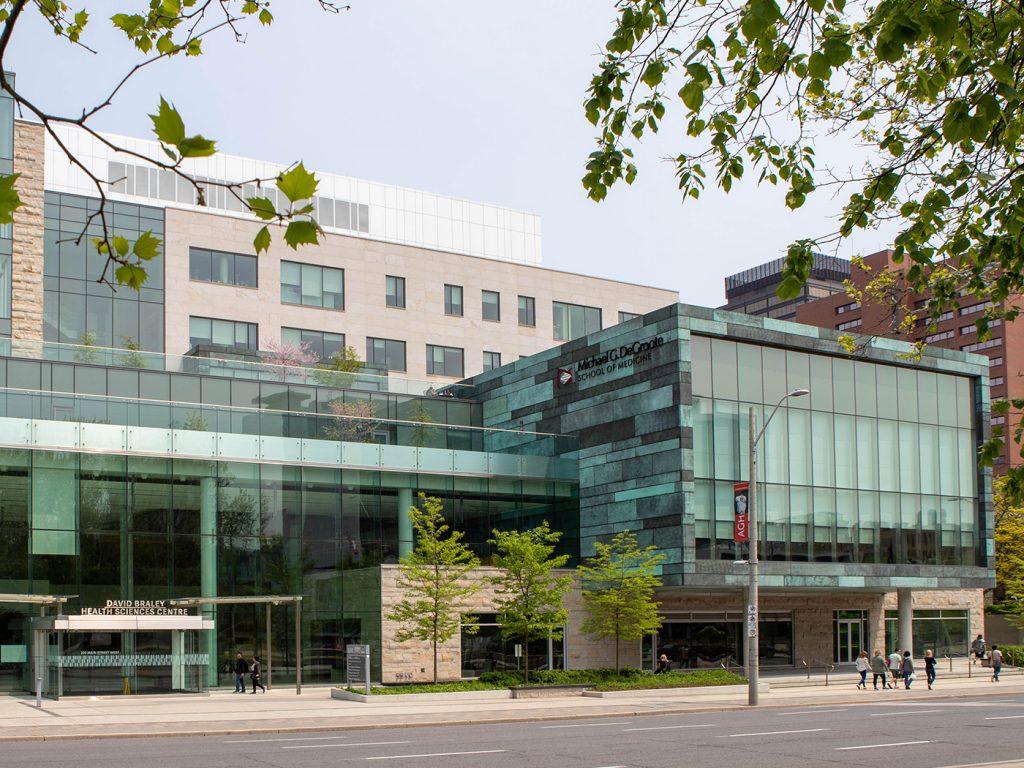Buildings & Sustainability
A leader in sustainable building design
All new buildings at McMaster are being developed with sustainability in mind. McMaster is committed to being proactive in reducing energy and water consumption through implementing retrofits in existing campus buildings. As technology advances its innovations in sustainable design, the university looks to implement them in all new construction.
All new construction at McMaster is now designed to LEED silver or higher certification in accordance with the Canada Green Building Council.
Main campus:
- Burke Science Building: LEED Silver Certified (’05)
- Les Prince Hall Building: LEED Certified (’06)
- David Braley Athletic Centre: LEED Certified (’07)
- Engineering Technology Building: LEED Gold Certified (’09)
- Nuclear Research Building Addition: LEED Gold Certified (’11)
- Ivor Wynne Centre – Spinal Cord Research Addition: LEED Silver (’12)
- R. Wilson Hall: LEED Silver Certification (’17)
- Peter George Living and Learning Centre: LEED Silver Certification (’19)
Other buildings:
- The CANMET building at McMaster Innovation Park: LEED Platinum Certification (’10)
- Ron Joyce Centre, Burlington campus: LEED Gold Certified (’10)
- David Braley Health Sciences Centre, downtown Hamilton: LEED Gold Certified (’15)
- Halton McMaster Family Health Centre: LEED Gold Certified (’17)
Engineering Technology Building
The Engineering Technology Building incorporates the latest in sustainable design and construction. It achieved LEED Gold certification due to sustainability features that include: rainwater harvesting for wastewater flushing and landscape irrigation; automated photo sensor controlled lighting; high recycled content in building materials; inclusion of local slag, a by-product of steelmaking, to reduce cement content in structural and landscaping concrete; a dual duct HVAC system that separates ventilation from space heating and cooling functions, coupled with heat recovery for exhaust air; and integration of mechanical systems with the building envelope and structure, incorporating the thermal mass of the structure as a heat sink.
L.R. Wilson Hall
L.R. Wilson Hall is McMaster University’s stunning home for the liberal arts. It houses state-of-the-art teaching and learning space, a 350-seat concert hall, and 20,000 square feet of space dedicated to the Indigenous Studies Program. It is LEED Silver certified for its efficiency and sustainability features such as roof gardens, which contribute to cisterns used for irrigation, motion sensor lights and heating, and a design that seeks to bring natural light into every space.
Gerald Hatch Centre
The Gerald Hatch Centre for Engineering Experiential Learning at McMaster University combines a home for undergraduate clubs with engineering research in a building that functions as a living laboratory of sustainability. The Centre was built to meet a zero-net energy threshold and to demonstrate its potential as a standalone resilient facility. The building design showcases how sustainable technologies can work together to reduce the environmental footprint and advance green technology and research.
Ron Joyce Centre
The Ron Joyce Centre is the home of the MBA and executive education programs of the DeGroote School of Business at McMaster University. Located at the Burlington satellite campus, the building is LEED Gold certified. This certification relies on demonstrating sustainable site development, water efficiency, energy efficiency, materials selection, and indoor environmental air quality. The sustainable features include: Low flow plumbing fixtures and high-efficient lighting, white roof to minimize the heat island effect, extensive use of construction materials containing recycled content, and green power sources for 50 per cent of the building’s electricity.
David Braley Health Sciences Centre
The David Braley Health Sciences Centre is LEED Gold certified and has a rainwater collection system which is part of the grey water system for the building. The building was designed to reflect the natural landscape of Hamilton and includes physical features that represent the city’s many waterfalls.
Peter George Living and Learning Centre
McMaster University’s Peter George Living and Learning Centre was completed in the fall of 2019. The 14-storey, 335,000 square-foot building is now the tallest structure on the main campus with gleaming glass towers. The building combines residence space, student activity space, and state-of-the-art learning facilities. It has been designed to LEED Silver standards.

